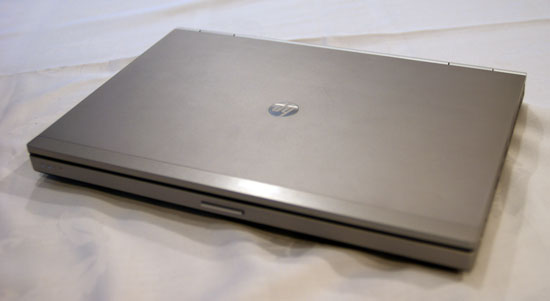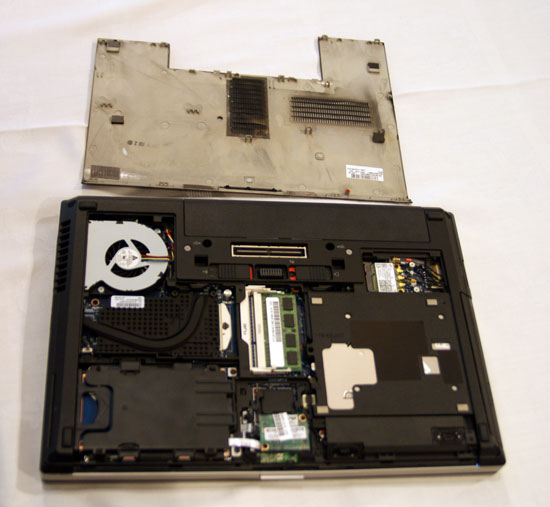HP's Business Notebook Hat Trick
by Dustin Sklavos on February 23, 2011 1:00 PM EST- Posted in
- Laptops
- IT Computing
- AMD
- Intel
- HP
- ProBook
- Radeon
- EliteBook
- Sandy Bridge
- 6000M
Coming in March: HP Updates in a Big Way
It's fair to say the refreshes HP announced for their consumer computers earlier this month seemed fairly lackluster. While nobody can complain about improved notebook speakers and the triumphant return of dedicated mouse buttons, there wasn't anything else remarkably fresh or exciting about their spring line. When we got a chance to meet with HP representatives in San Francisco to see their new business lineup, however, we saw very nearly the complete opposite.

HP's EliteBook and ProBook lines have undergone a major overhaul since the last time we looked at them, which wasn't very long ago. The last one we saw was fairly attractive but seemed somewhat schizophrenic in its aesthetics, like a hodgepodge of elements from enterprise and consumer lines that didn't blend together. It was the notebook equivalent of the American version of The Ring, appropriating scenes from its predecessor while gracelessly trying to integrate new material.
That's not the case with the new lineup. HP's designers have produced what have to be some of the most stylish notebooks we've seen, marrying some of the better trends in consumer notebooks to thoughtful, modern-looking engineering and design. You could argue they're cribbing from Apple a little bit, but that would do them a disservice.

HP is using aluminum on the lids of all of their new enterprise notebooks along with a single piece of machined aluminum for the interior panel with the ports cut into it. Internally they've employed a magnesium alloy chassis, and together with the aluminum shell these notebooks feel incredibly rigid and durable. In fact, in addition to having a mag-alloy backplane for the screen, HP also uses rubber padding between the bezel and screen to ensure it never compresses against the keyboard the way some cheaper notebooks can.
That keyboard is spill-resistant, with channels built into the frame beneath it, though depending on how you feel about the keyboards HP employs on their consumer line you may be pleased or disappointed to see the same chiclet-style keys on their enterprise-class kit. They've also gotten rid of touch-based buttons along with pretty much the entire control bar above the keyboard, instead replacing it with a couple of actual quick-access buttons. It's a decision that simplifies the look while improving usability.
What was probably my personal favorite feature had to be the bottom panel mechanism they're using on these new notebooks. Check this out:

The bottom panel of the notebook is a single large piece that can be removed by simply squeezing a latch and sliding it off, allowing for easy access to all of the internals. It's such a smart idea that one wonders why we don't see it more often—we'd love to get such a feature on more consumer laptops! And for the IT people that don't want to worry about employees popping it off and potentially damaging the components, the mechanism can be locked by installing a single screw. Most people probably won't get that much mileage out of something like this, but it does make the notebook easier to service, along with being easier for people like me (and at least a couple of you) to tinker with.










46 Comments
View All Comments
oshogg - Wednesday, February 23, 2011 - link
I would like to know more about the W series and IPS display possibility as well.oshogg - Wednesday, February 23, 2011 - link
I wonder why HP doesn't provide an option similar to Thinkpad's bay battery. The amount of space used by a CD/DVD drive is a big waste for many business users. Pretty much all of file I/O is done via USB thumb drives. Most software installations are done via network (including the OS install in many corporate environments).Osho
peterfares - Thursday, February 24, 2011 - link
+1. Or just have some models which omit the drive to make the computer smaller, with the option of a slice battery which will make it the normal size while extending the battery life.This isn't 4 years ago where omitting the optical drive was a big deal. No one uses them anymore.
MrSpadge - Wednesday, February 23, 2011 - link
"Sales of ultraportables out here are fairly low while the Asian markets tend to eat them up and forego the larger desktop replacement models."LOL - that's probably because the average US-citizen weights about twice as much as the average Asian. Well.. sorry, just kidding.
Actually I've recently been to Sydney and seen an absolutely amazing amount of huge cars with V6 and V8 engines. But apparently they're not driving them because they'd be so fat - no, it's because the city is built like one huge suburb with plenty of space everywhere.
MrS
YpoCaramel - Sunday, February 27, 2011 - link
Token Asian reporting in here: I in fact do use a 12" Asian Probook 5220, replaced an eeePC with it and it's a good machine, I welcome the extra power. That said, it's very slightly bigger and I would prefer something even more 'ultraportable' hahajah1subs - Wednesday, February 23, 2011 - link
As a business user looking at these new notebook computers, my first consideration, assuming adequate specifications is: are the displays matte or glossy.I am using a Dell Vostro 1500 and the display bothers my eyes for reading almost anything.
Are these displays going to be easy on the eyes?
Or, do we even know enough to guess whether or not they have a chance of being easy on the eyes?
Since these are more expensive than consumer notebooks, I am hoping this is the case.
JarredWalton - Wednesday, February 23, 2011 - link
Unless something changed since the last iteration, ProBook and EliteBook are all matte (thank goodness!) It baffles me how the whole business world generally goes with matte, but then somehow the consumer market is 99% glossy. Businesses - that actually use their systems for work - prefer glossy. And no one seems to think that some consumers would prefer matte as well? Of course, the latest matte LCDs are horrible on contrast and color (like 200:1 contrast at best), unless you get a really expensive display (Dell RGB LED, HP DreamColor, etc.)Justin Time - Wednesday, February 23, 2011 - link
"somehow the consumer market is 99% glossy"Mfgs have done their homework, and they know that consumers prefer to buy glossy and shiny baubles over dull and practical.... New + Shiny = Better.
VJ - Sunday, February 27, 2011 - link
Consumers in a shop will typically always prefer the glossy item when it's been setup next to the matte item. I actually prefer less contrast and feel that many of these 'objective' measurements found in tests are misleading. My HP with it's 1680x1050 (purchased in 2008 for 710 euro incl. VAT) may not score as high in these tests but the screen looks like paper with colors which I prefer to many Mac Books and the likes I see around me. Then again, I used to turn down contrast and brightness on my TV, especially when viewing for longer periods of time.You may prefer high contrast air brushed paintings over a van Gogh, like many people prefer Adderall over a balanced life style. Laptop manufactures are like drug dealers.
darwinosx - Wednesday, February 23, 2011 - link
As an IT Architect I've had just about every laptop brand there is issued to me at one time or another. The HP W series are easily the best PC laptops I have ever used. I much prefer Macs but if you must use Windows these are the way to go. On the other hand I think HP's consumer series of laptops are cheap pieces of junk. There is also a huge difference between HP's business support and consumer support.